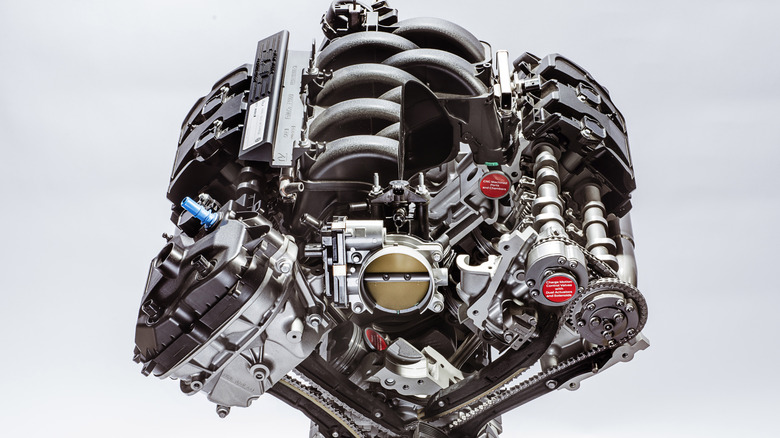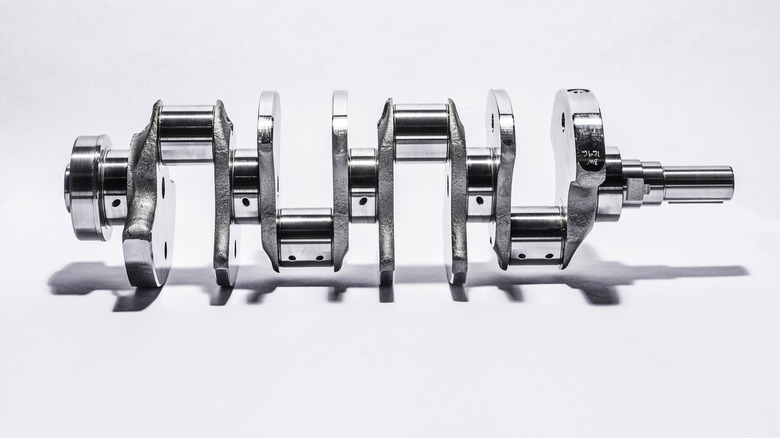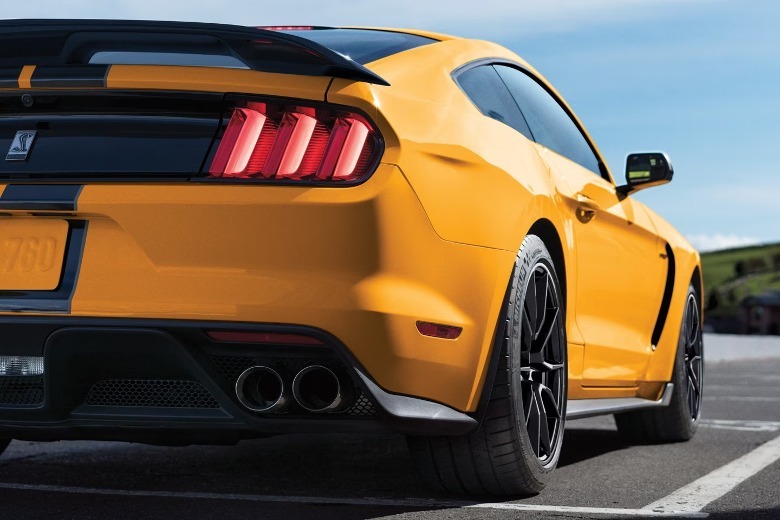Here's What Makes Ford's 5.2L Voodoo V8 Engine So Special
Ford and its Ford Performance racing subsidiary had something neat in store for the revival of its Shelby Mustang GT350 and GT350R that it unveiled in 2015. Touted as the best race-ready Mustang to hit the streets, the modern GT350 has a different type of muscle underneath its bulging hood. It's unlike any V8 engine in a typical pony car, producing 526 horsepower, 429 pound-feet of torque, and revs to a bewildering 8,000+ rpm, all without supercharging or forced induction.
The best part, however, is the howling exhaust note that would make a Porsche 911 GT3 or Chevy Camaro Z28 scamper for cover. The Shelby Mustang GT350 shares its Voodoo V8 engine with the race-ready GT350R — a modified version of the Coyote modular V8 with 5.2 liters of displacement. However, what made the Voodoo V8 so special was not its 87-millimeter throttle body (the largest in a Ford engine), astronomical 12:1 compression ratio, or aggressive cams with low friction rollers.
Ford Voodoo V8: Flat-Plane Crankshaft
The star of the show is the Voodoo's flat-plane crankshaft. Modern V8, V10, or V12 engines typically come in cross or flat-plane crank designs. The crankshaft connects to the pistons and sends power to the transmission to turn the wheels. The crank design has much to do with how efficiently the engine produces power while producing an intoxicating exhaust sound.
The cross-plane crankshaft in the Voodoo V8 has four crank pins on two planes offset by 90 degrees, resembling a "cross" or plus sign (+). The design enables a firing order with two exhaust firings that give muscle car engines that barrel-chested exhaust sound. On the other hand, a flat-plane crankshaft has all the crank pins in a single plane, with the connecting journals placed at an opposite 180 degrees, enabling an alternating firing order from one bank to the next.
Engines with cross-plane crankshafts run smoother due to their counterweights at the expense of performance and weight. However, flat-plane crankshafts are lighter, have less reciprocating mass, and can spin quicker at higher engine speeds, leading to faster acceleration and better performance. These advantages led Chevy to develop a flat-plane LT6 V8 for the Corvette Z06, which sounds unholy at full chat if you haven't heard.
Voodoo makes way for Predator
Ford redesigned the Voodoo's internals for the 2019 model year, despite planning to retire the engine in 2020. Unbeknownst to many, Ford was prepping the launch of Predator: a modified Voodoo with new blocks, heads, connecting rods, and an oversized Eaton supercharger.
Predator made its way to the Shelby Mustang GT500 in 2020, pumping out a whopping 760 horsepower and 625 pound-feet of torque. Another significant difference is the absence of the Voodoo's flat-plane crank design, making way for a conventional cross-plane crankshaft.
As expected, the Shelby Mustang GT500 is a beastly muscle car. With the Predator engine routing power to a Tremec seven-speed dual-clutch automatic gearbox, the GT500 roasts the quarter mile in 11.4 seconds at 131 mph, and goes from 0-60 mph in 2.1 seconds.
That being said, the GT500 has no available manual gearbox from the factory (there are aftermarket upgrades for about $19,000 to $20,000), and it starts above $100,000. Meanwhile, the Shelby Mustang GT350's Voodoo engine, six-speed Tremec manual stick, and attainable $60,000 base price, made it an icon before production ended in 2020.




